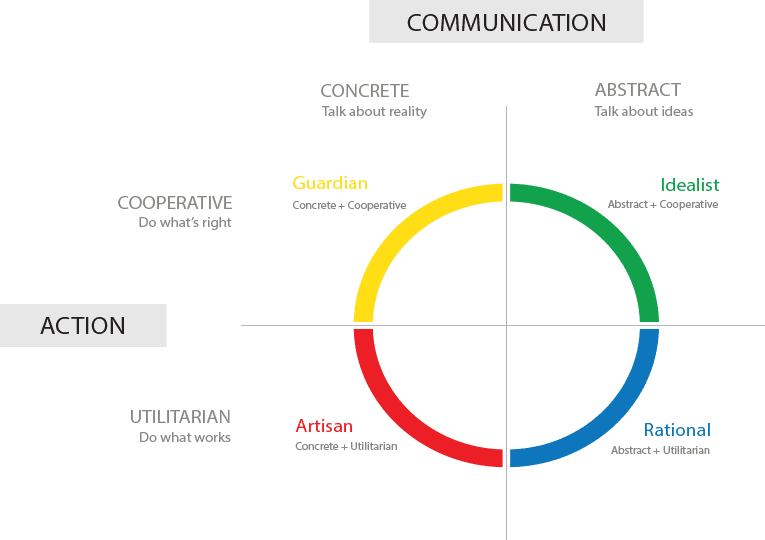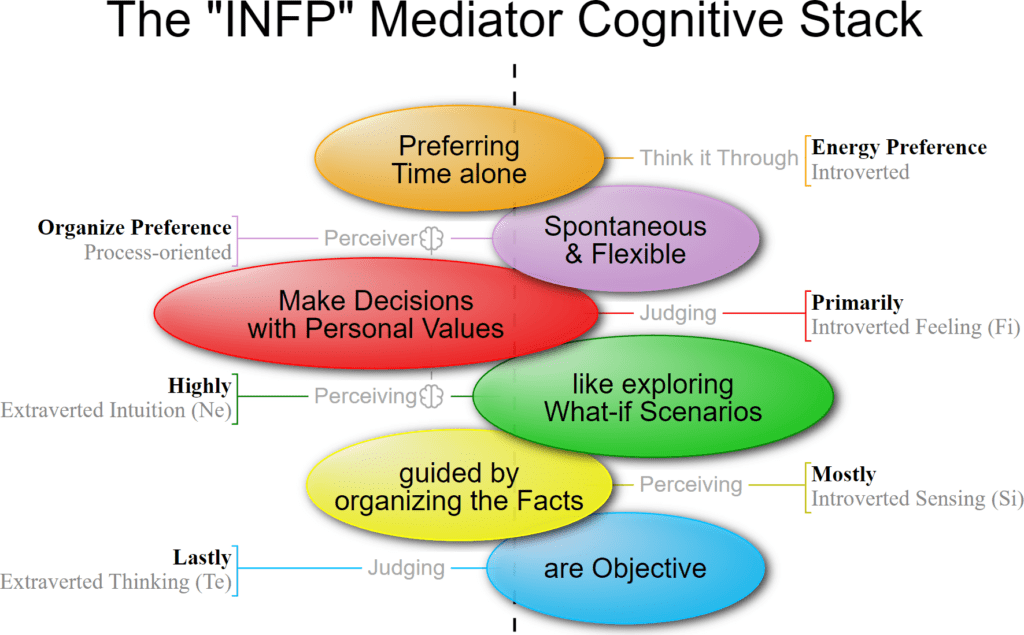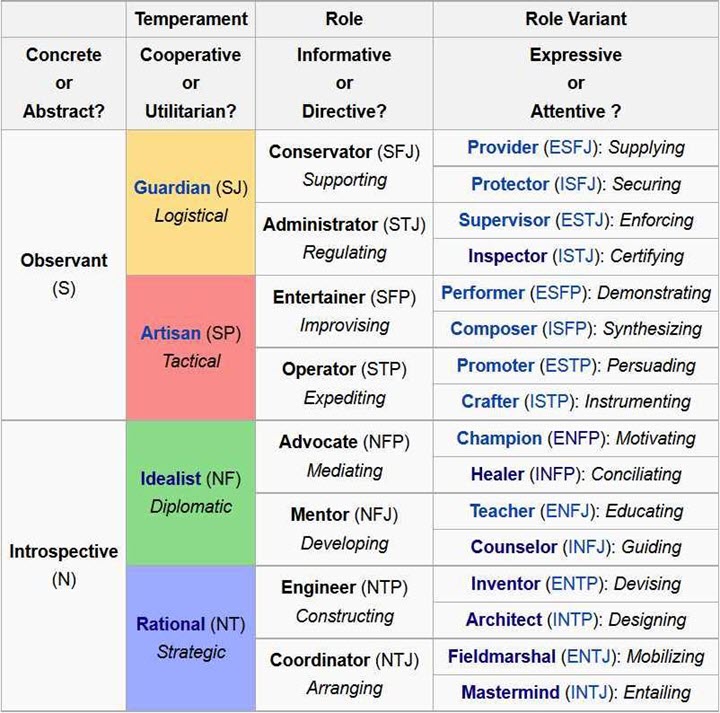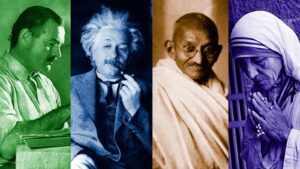What is the Keirsey INFP “Healer” Personality Type?
The Keirsey INFP “Healer” Personality Type is an Idealist Temperament with an Abstract Communication Style and a Cooperative Action Style.
Keirsey organized the Four Temperaments as a matrix. There are two communication styles, abstract and Concrete, similar to the Myers-Briggs Intuition (Abstract) and Sensing (Concrete) “Perceiving” Cognitive Functions.
And by two action styles: Cooperative and Utilitarian. Utilitarian people, for the most part, do what works, while Cooperative people do what’s right.
Keirsey named the Four Temperaments as suggested by Plato: Artisan (Iconic), Guardian (Pistic), Idealist (Noetic), and Rational (Dianoetic).

Concrete versus Abstract Communication Style
Keirsey divided the Four Temperaments into two Communication Styles: Abstract and Concrete. These styles resemble the Myers-Briggs Intuition and Sensing “Perceiving” Cognitive Functions.
Some people talk primarily about everyday reality’s external, concrete world: facts and figures, work and play, home and family, news, sports, and weather—all the who, what, when, where, and how of life.
Other people talk primarily about the internal, abstract world of ideas: theories and conjectures, dreams and philosophies, beliefs and fantasies—all the whys, ifs, and what might be of life.
Concrete people talk about reality in their daily lives, while Abstract people talk about ideas.
According to Keirsey, everyone can engage in both observation and introspection. People are observant when they touch objects or otherwise perceive the world through their five senses.
When people reflect and focus on their internal world, they are introspective. However, individuals cannot engage in observation and introspection simultaneously. The extent to which people are more observant or reflective affects their behavior.
People who are generally observant are more ‘down to earth.’ They are more concrete in their worldview and focus on practical matters such as food, shelter, and their immediate relationships. Carl Jung used the word sensation when describing people who prefer concrete perception.
Generally, reflective people have more ‘heads in the clouds’ and abstract worldviews. They focus on global or theoretical issues such as equality or engineering. Carl Jung used the word intuition to describe people who prefer abstract perception.
Cooperative versus Utilitarian Action Style
Some people act primarily practically or pragmatically; that is, they do what gets results, what achieves their objectives as effectively or efficiently as possible. They only check afterward to see if they observe the rules or go through the proper channels.
Other people act primarily cooperatively or socially acceptable; they try to do the right thing in keeping with agreed-upon social rules, conventions, and codes of conduct. Only later do they concern themselves with the effectiveness of their actions.
These two ways of acting can overlap, but as they lead their lives, Utilitarian people mostly do what works, while Cooperative people do what’s right.
Keirsey compares the differing temperaments with cooperative (Complying) and pragmatic (Adaptive) temperaments. Cooperative people pay more attention to other people’s opinions and are more concerned with doing the right thing. Sensible people (Utilitarian) pay more attention to their thoughts or feelings and are more concerned with doing what works.
Keirsey compares the differing temperaments with cooperative (Complying) and pragmatic (Adaptive) temperaments. Cooperative people pay more attention to other people’s opinions and are more concerned with doing the right thing. Sensible people (Utilitarian) pay more attention to their thoughts or feelings and are more concerned with doing what works. No comparable idea in the MBTI or Jung corresponds to this dichotomy, which is a significant difference between Keirsey’s work and Myers and Jung’s.
The pragmatic temperaments are Rational (pragmatic and abstract) and artisan (Pragmatic and concrete). The Cooperative Temperaments are Idealists (Cooperative and Abstract) and Guardians (Cooperative and Concrete). Neither the MBTI nor Jung included the concept of Temperament in their work.
INFP Keirsey/MBTI Correlation
| Keirsey | MBTI | |
|---|---|---|
| I | Attentive Role Variant | Introverted Feeling |
| N | Abstract Communication Style | Extraverted iNtuition Auxiliary Function |
| F | Cooperative Action Style | Introverted Feeling Dominate Function |
| P | Utilitarian Role | Intuition is a Perceiving Function |
With Introverted Intuition as the first Dominant Function and Extraverted Thinking as the second Auxiliary Function, the MBTI INFP “Mediator” Personality Type sorts to the Keirsey INFP “Healer” Personality Type.

INFP Personality Type cross-reference
- Keirsey Type – Healer
- Temperament Type – Phlegmatic
- Animal Type – Otter
- DISC Type – Influential
- Socio-Communicative Type – Expressive
- True Colors – Blue
- Color Code – Blue
- Personality Compass – West
- Occupational Type – Artistic
- Learning Type – Theorist
- Leadership Type – Collaborator
Enneagram Types
Healer Personality Characteristics
Healers present a calm and serene face to the world and can seem shy, even distant, around others. But inside, they’re anything but quiet, having a capacity for personal caring rarely found in the other types.
Healers care deeply about the inner life of a few particular persons or a favorite cause in the world at large.
Their great passion is to heal the conflicts that trouble individuals or divide groups and thus to bring wholeness, or health, to themselves, their loved ones, and their community.
Healers have a profound idealism derived from a strong personal sense of right and wrong. They conceive the world as an ethical, honorable place full of wondrous possibilities and potential goods.
To understand Healers, we must know that their deep commitment to the positive and the good is almost boundless and selfless, inspiring them to make extraordinary sacrifices for someone or something they believe in.
Set off from the rest of humanity by their privacy and scarcity (around one percent of the population), Healers can feel even more isolated in the purity of their idealism. They might also feel a sense of separation because of their often misunderstood childhood.
Healers who live a fantasy-filled childhood are the princes or princesses of fairy tales, an attitude that sadly is frowned upon or even punished by many parents.
With parents who want them to get their heads out of the clouds, Healers begin to believe it is harmful to be so fanciful and dreamy and can come to see themselves as ugly ducklings.
In truth, they are pretty OK just as they are, only different from most other swans reared in a family of ducks.
At work, Healers are adaptable, welcome new ideas and new information, and are patient with complicated situations but impatient with routine details. Healers are keenly aware of people and their feelings and relate well with others. However, because of their deep-seated reserve, they can work quite happily alone.
When making decisions, Healers follow their hearts, not their heads, which means they can make errors of fact but seldom of feeling.
Like the other idealists, they have a natural interest in scholarly activities and demonstrate a remarkable ability to use language.
They have a gift for interpreting and creating stories, and thus often write in lyric, poetic fashion.
Frequently, they hear a call to go forth into the world and help others, a call they seem ready to answer, even if they must sacrifice their comfort.
Famous Healers
Princess Diana, Richard Gere, Audrey Hephurn, Albert Schweitzer, George Orwell, Karen Armstrong, Aldous Huxley, Mia Farrow”, and Isabel Meyers are examples of Healer Idealists.

What are the Keirsy Personality Temerpaments?

David Keirsey, born in 1921, was an American psychologist specializing in conflict management and family counseling. He began researching human behavior and Personality in the 1940s.
Keirsey blended the Myers-Briggs Personality Types with Ernst Kretschmer’s model of the Four Temperaments, developing the Keirsey Temperament Sorter, which was made famous by his book “Please Understand Me.”
Instead of using the term Personality, Keirsey used Temperament. He viewed it as a configuration of observable Personality Traits, communication habits, patterns of action, characteristic attitudes, values, and talents. To Keirsy, Temperament encompasses personal needs, individual contributions, workplace contributions, and societal roles.
Keirsey correlated the sixteen MBTI Personality Types into Four Temperaments. He divided each Temperament into two Roles: informative and Directive. He subdivided the roles into expressive (extraverted) and attentive (introverted) role Variables.
Informative versus Directive Roles
Keirsey distinguishes between people who generally communicate by informing others versus those who speak by directing others. This distinction subdivides each of the four Temperaments into eight Roles.
Expressive versus Attentive Role Variants
Individuals who act before observing are Expressive. In contrast, people who follow before working are Attentive.
Expressive and attentive variants further subdivide the eight roles into 16 types correlating to the 16 Myers-Briggs personality types.


